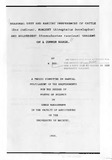Seasonal Diet and habitat preferences of cattle (Bos Indicus), Kongoni (Alcephalus buselaphus), and Wildebest(Connochaetes taurinus) grazing on a common range
Abstract
The feeding habits of cattle (Bos indicus), kongoni
(Alcephalus buselaphus) and wildebeest (Connochaetes
taurinus) whether as single species or in combination
with other animal species on the same range have been
studied by several researchers in different environments.
Generally these studies conclude that animals do select
their diets from an of array plants depending on what is
available to them and the prevailing conditions.
This thesis is the result of a study conducted at
Game Ranching Ltd. situated at the Athi Kapiti Plains,
Kenya, between January and August 1993, to determine the
diet and habitat preferences of cattle, kongoni and
wildebeest. The following six vegetation types
(habitats) occur in the ranch; Themeda grassland,
Balanites glabra tree grassland, Balanites - Acacia tree
grassland, Acacia drepanolobium dwarf tree grassland,
Acacia woodland and Acacia xanthophloea bushland.
The diet preference by the three herbivores was
determined by using microhistological analysis technique.
The three dominant grasses in the ranch Themeda triandra,
Digitaria macroblephara and Penisetum mezianum also
formed the major diets of the animals. The browse
component of the diets increased during the dry season by
about 100% irrespective of the animal species, with
cattle always having twice as much browse as the wild
v
herbivores. The animals, however, selected similar diets
in terms of plant species during both seasons. Dietary
overlaps were always above 75%, but higher during the dry
season, than during the wet season. The overlaps were
lower between cattle and wild herbivores than between the
wild herbivores.
During the wet season Balanites glabra tree
grassland was the most preferred while all other habitats
had negative preference indices, with Acacia woodland and
Acacia xanthophloea bushland habitats being avoided
completely by kongoni and wildebeest. During the dry
season the two herbivores shifted their habitat
preferences to Balanites - Acacia tree grassland habitat,
with Acacia xanthophloea being avoided completely.
Balanites - Acacia grassland seem to be the best
available habitat in the ranch as it is the habitat upon
which kongoni and wildebeest depend for their survival
during the dry season. Balanites glabra grassland,
however is the most preferred habitat but is only
available during the wet season.
Citation
Master of science in range managementPublisher
University of Nairobi Faculty of Agriculture, University of Nairobi

